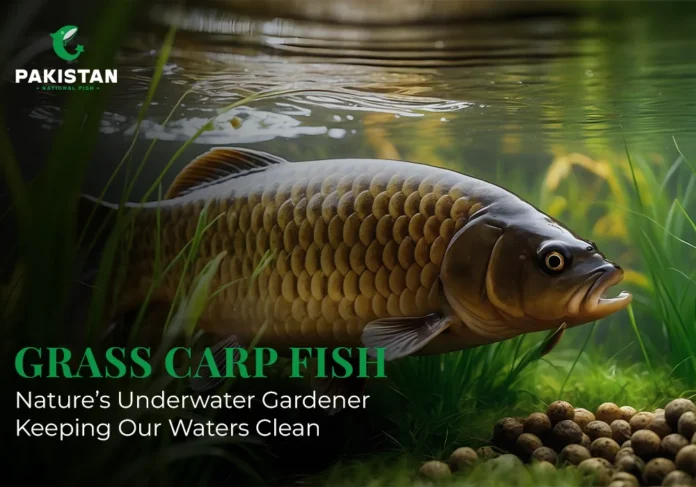The grass carp fish (white Amur) is one of the freshwater creatures that are unique, having a plant-based diet and an important role in controlling aquatic plant life.
This guide explores its origin, growth, uses in regions like Florida, and what to know about its size, behavior, and care.
What Are Grass Carp Fish (White Amur)?
Ctenopharyngodon idella, which is also known as grass carp, is a freshwater carnivorous fish of the carp family (Cyprinidae). In the aquaculture industry and aquatic weed management, especially, it is commonly referred to as white Amur or simply as grass carp.
Origin & Distribution
- Native Range Eastern Asia – northern Vietnam to China, eastwards along the Amur River (Sino-Russian border).
- Introduced Range – Its introduction is extensive worldwide (Europe, North America, some parts of Africa, etc.) to control the weed in water bodies.
- In most areas, sterile (triploid) grass carp fish are applied to control uncontrolled reproduction.
Grass carp fish lack barbels, and their overall body is long and torpedo-shaped with large scales (40-42 along the lateral line). Their color ranges from olive on top to whitish underneath. They spawn in fast-flowing rivers, where drifting eggs need long stretches to develop, making natural breeding rare in still waters like ponds or lakes.
Florida Grass Carp: Use, Regulation, and Management
Why Florida Uses Grass Carp Fish
Such invasive aquatic plants (e.g., hydrilla, water hyacinth) are problematic in Florida, as well as many other southern U.S. states, and they block waterways, limit recreational opportunities, and impair habitats.
Herbicides are costly and sometimes destructive chemically and through mechanical means. Alternatively, an alternative way of controlling the excess aquatic vegetation is through the introduction of triploid grass carp fish as a biological control measure.
Sterile (Triploid) Requirement & Permits
To prevent invasive reproduction, Florida only permits the release of triploid (sterile) grass carp, regulated by the FWC and FDEP. Stocking rates range from 2 to 10 fish per acre, based on plant density and lake size. Overstocking can deplete vegetation, disrupt ecosystems, and increase turbidity.
To ensure effective control, Florida maintains a triploid grass carp fish database to monitor stocking, performance, and environmental outcomes.
Notable Florida Case
Among the notable records is the fact that one of the triploid grass carp fish that was captured in Florida was 15 years old, 56 inches long, and weighed 75 lbs. They may be huge even under regulated conditions, as in the case there.
What Do They Eat?
The peculiarities of the grass carp fish refer to its diet, which is why it is called so.
Herbivorous Diet Feeding Behavior
Grass carp fish are strictly herbivorous (after reaching maturity). Small invertebrates or planktons may be eaten by juveniles, but with growth (around 2 to 3 inches), the juvenile changes its diet to plants.
They feed on extensive amounts of aquatic vegetation- submerged plants (hydrilla, pondweeds, chara), floating plants (duckweed), and occasionally filamentous algae (however, this is not their favorite). Under favorable circumstances, they have been known to feed on up to 3 times the weight of their body weight in a day.
In managed ponds and lakes, grass carp fish naturally control aquatic weeds, offering an eco-friendly alternative to chemicals or machinery. However, they can be selective eaters—avoiding tough, fibrous plants—and may reduce feeding or move elsewhere once their preferred vegetation is gone.
Big Grass Carp: What Size Is The Largest One?
When we speak of big grass carp, to what extent are we referring?
Maximum Potential & Records
- In an original or good environment, grass carp fish may grow to a length of about 1.4 m (approximately 4.6 feet) and a weight of about 97 lb (approximately 44 kg).
- One of the triploid Florida records was 56 in (= 1.42 m) and 75 lbs (= 34 kg).
- Other sources list extraordinary people in China reaching as much as 5 ft and 100 or more lbs (however, these are unusual).
Thus, large grass carp fish usually means those that are more than 3 ft / 30 lb in size, and extraordinary ones that are more than 50 -70 lb.
Growth Rates & Dynamics
The growth rates are quite high during the early stages. In a Florida experiment, grass carp fish had a length of 962 mm and a weight of approximately 15 kg in 48 months (4 years). According to other studies, some lakes grow to 10.0-10.4 g/day per day.
But development is very critical to the quality of the diet, the temperature of water, the density of stocking, and competition, among other ecological conditions.
Average Grass Carp Fish Size
Life Stage | Typical Length | Typical Weight |
Young / Fingerling | 3–7 cm (1–3 in) | grams (very small) |
Juvenile (1–2 years) | ~20–60 cm (8–24 in) | a few hundred grams to a few kg |
Adult / Common in Stocking | 60–100 cm (2–3 ft) | 10–30 lb (4–14 kg) |
Large / Exceptional | 120+ cm (4+ ft) | 40–100+ lb (18–45+ kg) |
Applications, Challenges & Tips to Use / Fishing
Applications
- Water weed: This is their primary application in the world. When properly managed, they will offer 24-hour-long, chemical-free control of plants.
- Aquaculture/food: Grass carp fish are also a food fish in the native Asian region, and feature in the cuisine of many local dishes.
- Sport fishing: Bowfishing and intrusion can be used to target grass carp, but in most areas, they have to be released (under a managed weed control program).
Challenges & Caveats
- Overstocking dangers: Excessive vegetation removal will destabilize ecosystems, raise turbidity, and damage aquatic food webs.
- Reproduction: Escape to natural waterways may result in undesirable reproduction (in diploid individuals) or ecological invasion.
- Selectiveness towards plants: It is not possible that they manage all plant species on the same level, and they can also abandon unwanted species.
- Management: There should be monitoring. When vegetation is controlled, the grass carp fish can either move to another food source or it will need harvesting or removal.
- Legal / permit restrictions: In many jurisdictions, the sale, possession, or stocking of grass carp, and more so non-sterile, is restricted.
Tips For Fish Grass Carp
- Only in case of certainty of containment of reproduction, use triploid (sterile) fish.
- Begin with a familiar stocking rate (e.g., 2-10 fish per acre in certain Florida situations), which should be modified according to per vegetation amounts.
- Check aquatic vegetation content and health condition of the system (oxygen, clarity) regularly.
- Should vegetation be exhausted, then there should be a strategy to remove or eliminate carp.
- For anglers, use heavier tackle (the fish are large and powerful) and techniques like using vegetarian baits or imitating corn/vegetation.
- Also, make sure to follow local regulations on harvest, catch-and-release, permits, and protected status.
From small farm ponds to huge lakes of Florida, the grass carp is constantly demonstrating its own value as the silent gardener of nature. By learning its habits, growth, and influence, it is possible to make sure the amazing fish continues to be a helpful companion as well as a healthy component of freshwater ecologies.
Conclusion
The grass carp fish (white Amur) forms a cross-over between ecology, aquaculture, and environmental management. It consumes plant life, which puts it in a natural position of controlling aquatic vegetation similar to the Florida grass carp initiatives; however, a careful balance is necessary so as to prevent the destruction of ecosystems.
Although huge grass carp may be more than 3 feet, the mean size depends on the habitat. It is a captivating narrative in the eyes of the Breeze Fish Point audience with careful management and interesting pictures.


